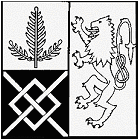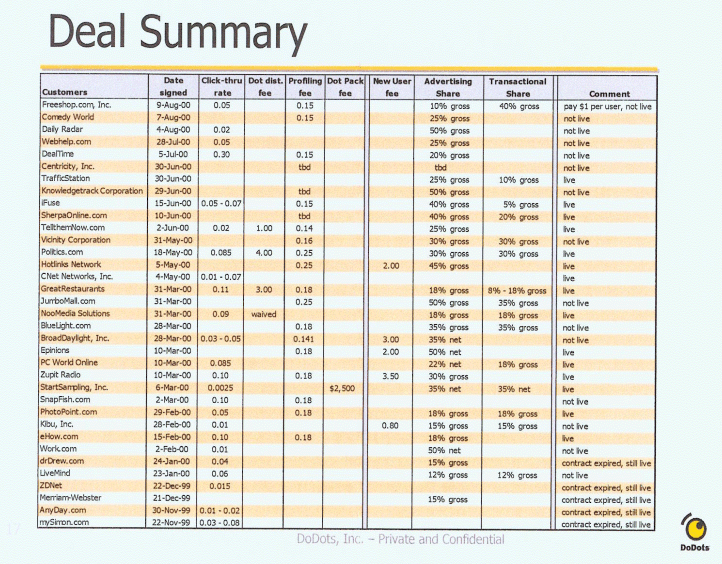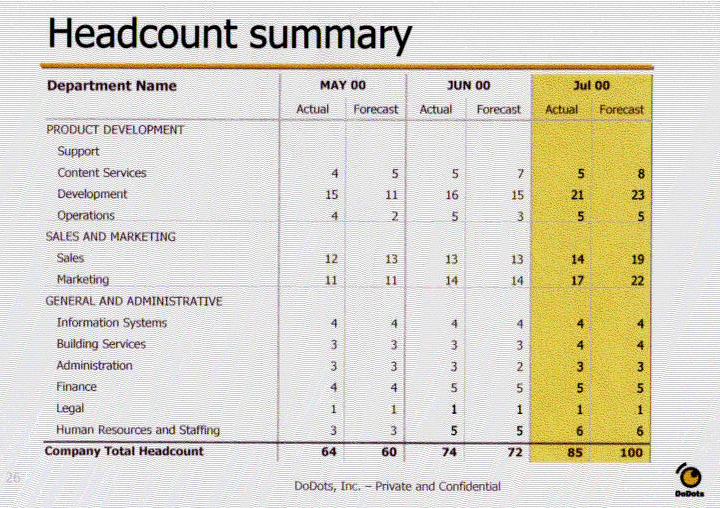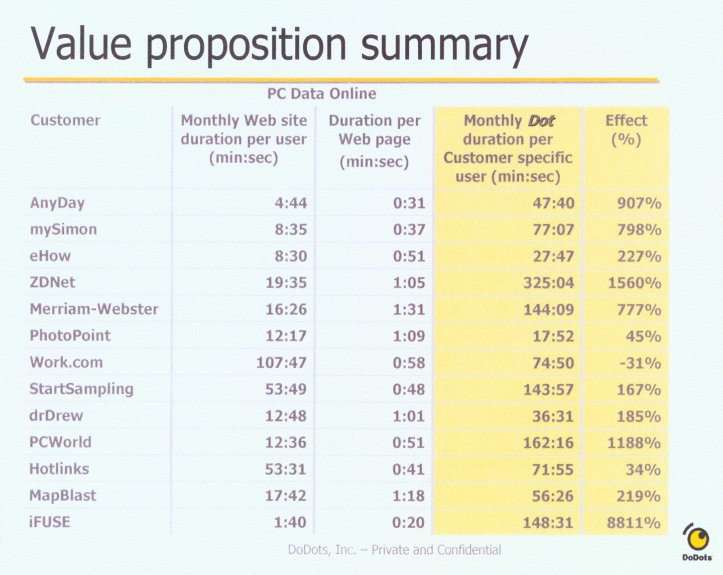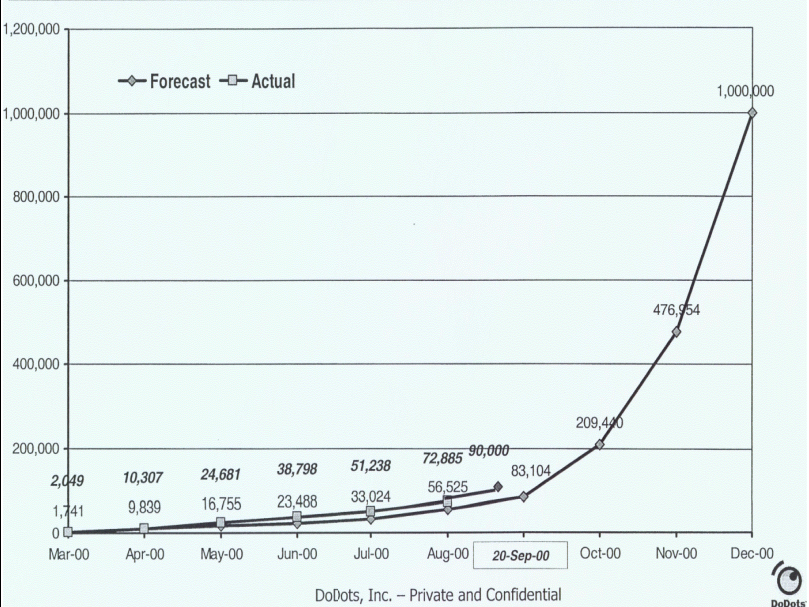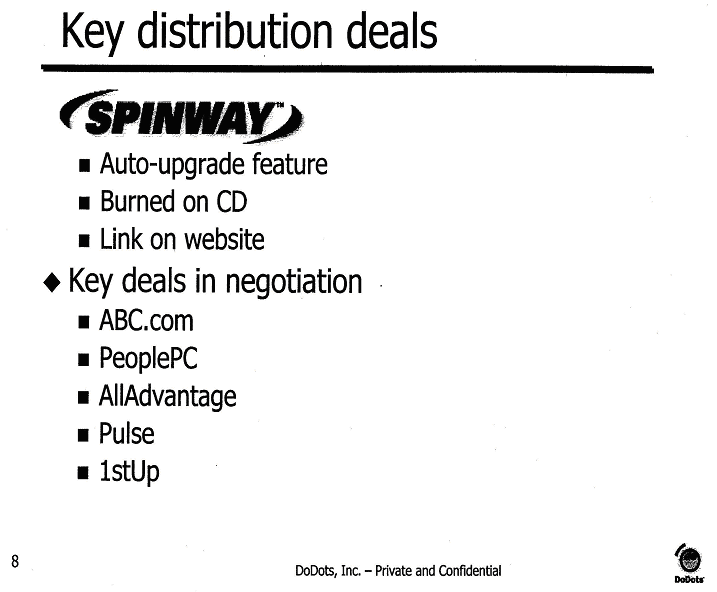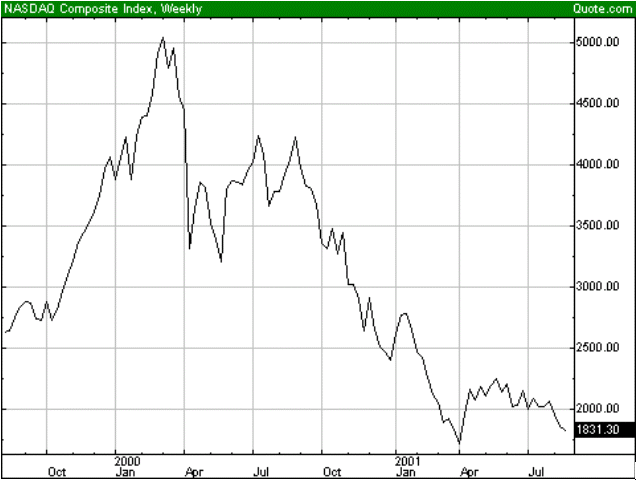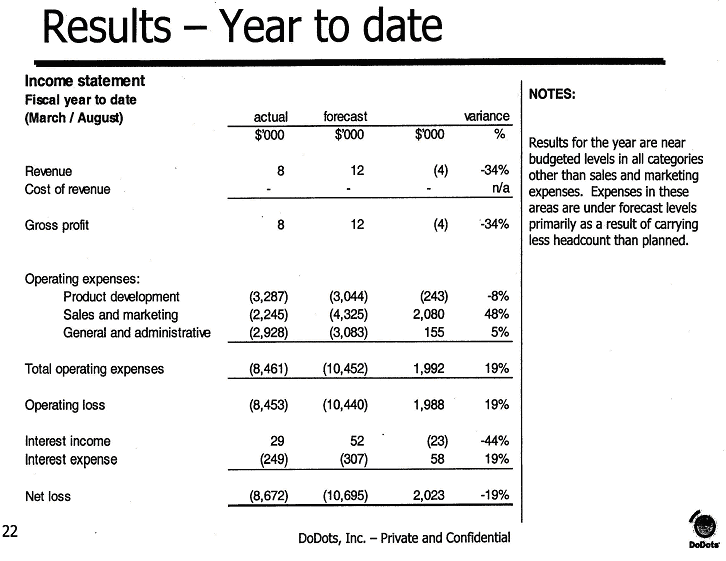|
By about May 1 the cash situation at DoDots had not improved and the executive team was nervous. Vendors were starting to
call more frequently about their bills, but Medrano and the finance department was decidedly tight with their cash as they knew it would
take a few weeks at best to finalize any Series B investment. Medrano began focusing on John Staenberg, the Managing Director of
Staenberg Venture Partners, as the most likely lead investor for the Series B round. Medrano stated,
|
"We talked with numerous other venture capitalists, and DoDots received a lot of interest from some large late stage
funds like Thomas Weisel Partners and Goldman Sachs Private Equity. Many were interested, but almost no one was investing at the time.
They had seen the IPO window close and many of the "mezzanine funds" were left holding expensive baggage. Everybody decided to take a
"wait-and-see" approach and DoDots was really caught between a rock and a hard place after Chase H&Q backed out of the term sheet at
the last minute." |
So on May 1, Medrano and the DoDots team worked on convincing Staenberg to lead DoDots' Series B. Medrano knew that
Staenberg's small venture fund could react quickly and independently. Staenberg was also fully capable of leading a venture round
and had a very good relationship with Heidi Roizen of Softbank, who was on DoDots Board of Directors. Staenberg was classmates
of Roizen at the Stanford Graduate School of Business, and the two had since worked together on numerous venture deals.
The DoDots team felt good about his relationship with Roizen and was confident that he could be counted on to close a deal once
he committed.
However, Staenberg was usually not a lead investor. He had just opened a new fund, Staenberg Venture Partners II,
which was planning to be $80M. Therefore, he obviously didn't have the capital to make a single $20M investment in a company,
especially since this was potentially going to be the first investment of his new fund. Staenberg usually "followed" a larger
lead investor such as Softbank or Kleiner Perkins in most of his transactions and invested only in $1-2M chunks in order to diversify
the holdings of his small fund.
Nevertheless, Medrano was worried about getting any lead investor in the time required for DoDots to make its June payroll.
He viewed going after Staenberg as the lead investor less than ideal. However, considering the situation the company was in,
it seemed to Medrano and the team to be the strategy with the highest probability of success. Plus, the NASDAQ had rebounded to
over 3500 and many thought it would continue to rise. (see Exhibit 7) Leading a round would be somewhat new for Staenberg, and having
him invest only a few million dollars in a $10-20M round was somewhat unusual. But, Staenberg was interested in working with the
company and his initial commitment was to invest $3M in DoDots at a $135M pre money valuation. Once Staenberg committed, Medrano
focused on closing the deal over the next two weeks. Besides the pressing cash issue, Medrano had the incentive to close by May 15th
due to the repricing of a warrant given to Western Technology Investments (WTI) as a part of an equipment backed loan.
May 15, was a very important day for a few reasons. First, it was very close to the day DoDots ran out of money.
They probably would have been able to make the June 1 payroll, but would have had to further extend their payables. This would
have been hard on a number of company relationships with vendors, and it would have indicated to a lot of people that DoDots was
in trouble. Furthermore, the repricing of the warrant owned by WTI created enough possible dilution to all shareholders to get
some attention. In this potential dilution, Medrano saw opportunity. If DoDots did not close its financing by May 15th, about
1% of the company would be given to WTI. Medrano used the warrant repricing as follows:
| "Investors need to be driven to close a deal. When the market is hot, competition from other investors provides
the incentive. Certainly, DoDots' cash needs would only be used against the company, and therefore could not be over-emphasized.
Under these market conditions, investors were no longer competing for deals. They all knew this, so some other incentive had to be
used. The May 15 warrant repricing was small, but it gave DoDots a date by which Series B investors could be driven to invest.
And since Softbank owned 1/3 of the company, and would likely be the largest investor in the Series B at this point, DoDots could
count on Softbank's support. Investors were now in the "driver's seat" and I had to use the potential of unnecessary dilution as
an attempt to drive the Series B." |
Both the DoDots founding team and Roizen still viewed this as an opportunity to invest in a great company. Now,
the price had even been reduced by 50%. DoDots was still perceived as a high-flying company, despite the early market turmoil,
and they still received much positive press coverage and investor interest.
DoDots team also felt that Staenberg would be doing them somewhat of a favor by moving so quickly to close the deal.
As further incentive to close the round before May 15th, the team offered to add Staenberg to the company's Advisory Board and
give him 24,000 shares of common stock in the form of a "beefed-up" Advisor package. This additional stock grant, made only to
Staenberg if he closed the deal by May 15th, enabled Staenberg's fund to effectively reduce the average price of the round to a
$110M pre money valuation. Medrano stated, "Staenberg had guts and was willing to help DoDots when we were in a pinch; we were
more than happy to compensate him for it."This grant helped retain Staenberg's interest in the investment during an extremely
volatile market without having to re-negotiate and/or delay the entire investment. It also appeared to get his attention, align his
incentives with the company, and focus him on completing the deal.
Then on May 7 Medrano was awakened by Staenberg on his cell phone at 5AM, a time at which there is often little
good news. What Steinberg said frightened Medrano. He told Medrano that about one half of the Limited Partners (LPs)
(i.e. investors) in his fund, Staenberg Venture Partners II, had backed out of their initial commitments to invest in his fund.
Staenberg Venture Partners II was unique in that it was both small ($80M) and highly demographically concentrated.
Most of his LPs were ex-Microsoft employees, who had become wealthy on Microsoft stock and angel investments in early stage technology
companies. They were not the typical LPs of large VC funds like Sequoia & Kleiner Perkins. Most of these large VC funds raised the
overwhelming majority of their money from large and relatively stable institutions like retirement funds and university endowments.
These types of LPs were usually very well diversified and invested only 5-10% of their capital in private equity, with only a portion
going to the technology sector. On the other hand, most of Staenberg's LPs were allocating the majority of their investments to
private technology companies. As a result of the quick and severe downturn in the technology sector, Staenberg's LP's had seen a
large chunk of their net worth evaporate and could no longer invest as much as they had planned in his venture fund.
Therefore, Staenberg was now only able to raise $40M, and he indicated to Medrano that his fund could not lead with a
$3M investment. Medrano recalls,"Staenberg was hoping to leave a voicemail for me at 5AM, but I picked up and immediately
worked with him to resolve this situation." Medrano was able to convince him that a $2M lead would suffice, as there were a
number of other interested investors who were ready to follow his lead. Roizen's relationship with Staenberg and the DoDots
founding team was also key to resolving this issue. She continuously supported the company and met with Staenberg a number of
times to do a bit of "arm twisting." Softbank, Roizen in particular, was very committed to closing this round.
Medrano worked feverishly to complete the deal, and was careful not to alarm potential investors by focusing on
the pressing cash issue. A mis-step here meant that DoDots would have to take an expensive bridge loan, which, in the team's
impression, would just prolong the agony and increase the risk of closing the Series B. The team also did not want investors to
take advantage of the situation by "nickel-and-dimeing" DoDots on various terms or delaying the cash infusion as a negotiation
tool. Effectively focusing the investors on the May 15 date was positioned as an opportunity to help DoDots avoid the warrant
repricing and an opportunity to get involved with a great company at a temporarily reduced price.
DoDots was now clearly out of the drivers' seat and the team was excited about the prospect of any investment in the next few weeks. Bad news from other companies in the technology sector seemed to increase each day. The team felt strongly that it was not the right time to hold out for high profile investors, negotiate terms or valuation, but instead to focus on raising cash--period. Possibly sensing this, on May 10th Staenberg fought to lower the valuation to $125M. Medrano knew the DoDots team had no leverage and was now more than comfortable with their new valuation as compared to other public and private companies. They quickly agreed to the new valuation and had their team of attorneys at Cooley Godward, led by Jim Fulton who had worked with the company since its inception, redraft the documents.
Throughout the document preparation process, Medrano continued to work closely with Fulton. May 15th was especially
hectic because in order to avoid the warrant repricing, all parties involved had to complete each and every formality required
for the closing. With both Staenberg and Softbank involved, the flow of information and the approval process was very cumbersome
and complex. In most venture deals there is some leeway and usually an extra day or two to take care of documents requiring
signature or wire transfers, but DoDots Series B did not have this luxury. Finding the general partners to sign each document,
dealing with the administrative processes of transferring money, and negotiating hundreds of pages of legal documents in a later
stage investment is much more complicated than closing a single investor in a Series A round.
In fact, "closing" the round by May 15 was the whole point of having Staenberg lead. Lowering the price to $125M and
giving Staenberg additional "advisor shares" were simply ways to compensate for the decimation the market was delivering to similarly
situated technology companies and overall market volatility which was causing others to delay. The teams' number one goal was to
make sure that DoDots had cash to make the June 1 payroll. So, on May 15, Medrano, Staenberg, Roizen, and their respective teams of
lawyers, spent eight hours in conference calls, going over to the complex terms of the documents.
Most of the conversations that day were directly related to the rights and privileges of the Series B shareholders.
Staenberg, as is common with most later stage investors, wanted to differentiate his rights from those of the Series A investors.
The reason for this is that different rounds of investors are in different economic situations. Softbank had paid 50 cents per
share for 1/3 of the company in the A round--they were far and away the largest shareholder. In the Series B round, Staenberg was
effectively buying about 2% of the company for $2M, and was paying about $10 per share. Roizen and Softbank had also committed to
invest their pro-rata share, so in this case, they invested one-third of the total investment in order to maintain their ownership
percentage and support the company. (Often, potential new investors will be scared away from an investment opportunity if current
investors are able, but unwilling, to invest more money in subsequent rounds. In this case, Softbank had allocated additional
dollars from its fund to support the company in subsequent rounds of funding.) So for example, if Staenberg were to invest $2M
Softbank would invest $1M.
What this meant for Staenberg was that if the "Preferred Shares" had their rights and privileges grouped together as a
combined class of both Series A and Series B, Steinberg would have little power in company matters due to his low overall
percentage of ownership. At first glance, this appears completely fair, however the incentives of the Series A and Series B
investors are not generally aligned due to the different prices they pay for their stock. For example, a $100M sale of DoDots
after Staenberg's investment, would return a huge profit to Softbank, but provide Staenberg with a loss. Steinberg wanted to make
sure he had as many veto rights as possible in order to protect himself from his misalignment with Softbank's interests.
Medrano stated,
| "The company's economic incentives were aligned very well with Softbank because their average price per share was so low.
Providing Staenberg many special rights could allow him to effectively hold the company hostage in a transaction that was beneficial for the remaining 98% of the company. He would be able to extract a lot of value from both the common stock holders and the Series A investors if his voting power was disproportionate to his ownership. This just wasn't fair for a holder of 2% of the company. But, on the other hand, DoDots needed the money and money talks. In the end, we made most of the sacrifices necessary to get the money in the door." |
So after a long day of negotiations and meetings with all of the parties' attorneys, the documents were signed and $2M from Staenberg, along with the $1M from Softbank, was transferred to the company on May 15. Closing this round under these conditions was indeed a significant accomplishment, and gave the team immense satisfaction. DoDots could meet its payroll, pay its vendors, and had time to close on additional funds from investors who were slower or more hesitant. But, it also appeared that the technology market might be recovering nicely, even though e-commerce and Internet content and advertising based companies seemed to continue their quick demise.
Jim Fulton, who was DoDots corporate counsel, worked closely with Medrano during all of the company's financial transactions. He commented, "That was the best crash landing I ever saw. Now, that we have some money in the bank and the terms set, let's go get the rest…….in a less stressful manner."
After closing this small investment with Staenberg and Softbank, the founders made an announcement to the entire company. Dani Apgar, DoDots' first employee and Director of HR & Operations, recounts,
| "The founders had a culture of communicating extensively with the employees and rallying employees around certain events like key hires, key deals, new customers and big investments. The whole company knew the Internet market had crashed, although many didn't understand just how much pause this gave most venture capitalists. All knew that DoDots was out raising money and they could see the lawyers and faxes everywhere." |
A loud horn went off, everybody stood on their desks, and Medrano went through some of the brief details of the investment. He told the company that they had gotten funded and that everybody's efforts in the company had produced one of the largest increases in valuation ever, even in the midst of the market turmoil. Apgar comments, "The Kembels and Medrano really rallied the company around the efforts of every contributor. They thanked everybody for everything they had done, and told the Company the details to give them the confidence that DoDots was getting funded and was doing well in this turbulent market."
Obviously, $3M in this market was not enough. A few months earlier DoDots had planned to raise $65M and had based most of their growth plans on raising a large chunk of money (see Exhibit 3). During April and May, the focus had quickly changed to getting any investor to lead the round at any valuation and getting enough money in the door to meet payroll. Now, the company had enough money to let the market settle and to bring aboard larger investments from larger VC funds. Meanwhile, DoDots, had almost doubled its headcount.
What this meant was that the closing of the Series B round with Staenberg and Softbank on May 15 was really not a true "closing." Under Medrano's original plan, Chase and Softbank would have invested the lions' share of $65M in a first closing. When Chase backed out of the initial term sheet, DoDots' strategy had to adapt quickly in the midst of a brutal market.
DoDots May 15th "close" was really the opening of their Series B, which was led by an initial commitment of Staenberg Venture Partners and Softbank, totaling $3M. Unlike the Series A documents, when DoDots felt the value of the company (and in retrospect, the market) was increasing weekly, Medrano ensured the Series B documents were written to allow investment over the next 90 days. So, immediately after closing on the first investment from Staenberg and Softbank, the management team continued to work with other investors to raise more money. Softbank had committed to investing its pro-rata share, and since this was 33% of total investment, they could be counted on to invest 1 dollar for every 2 that came in from others. One of Medrano's strategies now was to collect as much money as possible in order to leverage Softbank's commitment. Roizen and the Softbank partnership were still bullish on the company and were very supportive throughout the Summer of 2000. Having already established and closed a lead investor for the Series B made it easier for DoDots to attract small investors, as the majority of the financial and legal due diligence and negotiation was already complete. However, because Staenberg was a smaller and lesser known fund, it made attracting more established and larger investors, like Goldman Sachs or Technology Crossover Ventures, more difficult. Medrano recounts,
| "Documents and terms were already set, so there was little opportunity for investors to drag things out or nit-pick. I was hell-bent on finding that lead investor to set a price and the terms so all of the investors who were waiting by the edge of the pool would finally jump in." |
Some jumped and others did not. Conversations with Chase during this time period had continued. Now that DoDots was in a less vulnerable position, it appeared to be the right time to re-engage Chase. Charlie Walker from Chase, and the Managing Partner of their venture capital arm, was still interested in investing. Medrano had chosen to wait to re-engage them as they could not move as fast as Staenberg, were much more bureaucratic in their approval processes, and there was less trust between them and the DoDots team. However, DoDots needed the money and was very interested in the strategic relationships and notoriety that a large organization like Chase, and a prominent banker and venture capitalist like Charlie Walker, could bring to the table. Ten days after Staenberg's lead investment, Chase invested $3M and Walker took a seat on the company's Board of Directors. This also brought in an additional $1.5 from Softbank.
Now, with Staenberg, Chase and Softbank onboard and a reasonable amount of money in the bank, Medrano focused on many small investors who had previously expressed interest, but were not as crucial to the round as Staenberg or Chase. Numerous Angel investors had been in touch with the company over the preceding 6 months. One was the former CFO of China.com and a Softbank Entrepreneur-in-Residence named David Kim. Kim also knew the Kembel brothers from when they were undergraduates at Stanford together. Kim invested $1.5M, and along came Softbank's $750K.
Meeting, pitching and closing each of these small investors was time consuming and energy intensive. However, Medrano and the team wanted as much cash as possible and were working hard to leave no stone unturned. Simultaneously, at an introduction from Joe Vetter, an early investor in the company, the DoDots team closed a $200K investment from Morris Ventures.
Additionally, many service providers in Silicon Valley had started taking equity in their clients and had begun their own small investment funds. DoDots' PR firm, real estate firm and law firm all contributed small amounts to the round. All of these investments helped fill-out the Series B round and increased Softbank's total commitment, but each required time and attention from the management team.
Meanwhile, DoDots executive team was still pitching dozens of larger VC funds and "strategic" corporate investment groups like Oracle and AOL all over the country. Finally, two more venture firms committed to the company's Series B. Platform Ventures put in $500K and Merrill Lynch Private Equity invested $1M. With Merrill's investment came a relationship with another set of prominent investment bankers who had become extremely successful taking technology and Internet companies public over the preceding months. The private equity investors from Merrill also introduced the DoDots executive team to Henry Blodgett, an Internet analyst, who had become famous for predicting the initial success of Amazon. Blodgett's coverage of numerous Internet companies some say had started the Internet investment boom of 1999, and his coverage of key companies had certainly helped Merrill's investment banking business. Blodgett met with the DoDots team, was excited about the technology and pledged his support for the company when the IPO window re-opened. This was precisely the type of relationship DoDots was looking for and one of the primary reasons they targeted Merrill and a Series B investor.
Merrill's investment increased the total size of the round to $15M and exhausted the potential investors that the company had contacted. Now it was already mid-August. DoDots' management had been on the road the entire Summer, presenting to VC funds from San Hill Road to New York City, all the while producing due diligence materials, and working through sales and technology licensing strategies.
Essentially, Medrano, the Kembels and much of the DoDots management team had been spending anywhere from 25-50% of their time on investor related matters over an 8 month period. Medrano and George Kembel spent even greater percentages of their time crafting, attending and following up with every meeting. "Managing dozens of investors during an investment cycle is an extremely time consuming affair," Kembel stated. Medrano recalls,
| "Fundraising is exhausting. George and I were constantly on the road, with two to three meetings a day that whole Spring and Summer. This was five months of trying to squeeze blood from a turnip. We needed the money and that was our first priority. However, it took away from other very important things….like running the company." |
While the team was fundraising, the company continued to grow. The various department heads were filling out their teams (see Exhibit 3). DoDots continued to sign customers and perform well by a number of metrics after their beta product launch (see Exhibits 4 & 5). Meanwhile, the market continued to fall (see Exhibit 7) and put increased pressure on all technology companies. Companies on the Nasdaq, especially "DotComs," started to close up shop. By October, DoDots noticed that a lot of its customers had gone out of business or were unable to pay to license DoDots' software. The metrics by which DoDots was measuring the success of its customers--increased duration and frequency of use--were not leading these companies to profitability. The industry was also slowly starting to feel the weight of a bear market that was taking longer than expected to completely recover.
By this time DoDots had grown to over 100 people, and its burn-rate was approaching $2M per month. More importantly, DoDots' revenue remained flat, with any growth being off-set by the decimation of the company's customer base. DoDots had intended to focus on distributing the product and making money on revenue sharing arrangements with its customers. (see Exhibit 2) In 1999 and early 2000, when revenue projections for DotComs and even DoDots' larger customers were extremely large, this seemed like a good strategy. With the turn in the technology and Internet markets, DoDots appeared to be in a bit of trouble.
DoDots was also going to have an even higher burn-rate soon. The executive team had made all of their projections based on a growing economy and customer base and had scaled the company according to the market of '99 and early '00. Additionally, the debt that DoDots had incurred from Lighthouse and the equipment financing from WTI, would add about $100K per month in January of '01. DoDots had borrowed $2M from Lighthouse Capital in a drawable, subordinated line, with the intention of financing the company through the Y2K period and as a safety net in the event that the Series B was delayed. The company was fortunate to have the cash available when Chase backed out of the first term sheet, but repayment was approaching and revenues were not developing as projected. Medrano stated,
| "One thing that should have given us a hint of things to come was that the investors we met with in February were shown a set of user and revenue projections before the launch of our product. Well, when we went back to those same investors in July and August they were disappointed in our actual revenue numbers (see Exhibits 5 & 8). By September, the projected and actual numbers were vastly different due to both the down market and our over-confidence in customer acceptance and growth." |
Some of the company's earlier customers were using and distributing DoDots' technology very well, but the majority of our customers were doing very poorly. They had signed a number of customers who were excited about the company's technology, but the technology was not used by their customers in ways that generated DoDots revenue. Therefore, DoDots missed its revenue targets.
By July, the DoDots team noticed that it's model of customer-based distribution would not have the massive distribution and revenue effects as it earlier anticipated. They began to look to a few large, strategic deals in order to make up for the demise of their DotCom customers. One of these was a technology licensing deal with ABC.com. Jim Mackraz, DoDots VP of Engineering recounts, "Our engineering team worked day and night for a month to make ABC happy. We thought this deal would put us on the map. In the end, they had leverage in negotiations and we got little revenue. Plus, they had wildly overestimated what the traffic to their website was and what it would do for DoDots."
Another key strategic deal was in the works with Spinway.com, a Softbank portfolio company, and K-Mart's newly christened ISP. Spinway was interested in using DoDots technology in order to provide its users with an enhanced user-interface through which it could advertise. In return, Spinway offered distribution to millions of users, which DoDots thought it could turn into revenue by charging its other customers for access. Negotiations with Spinway were time consuming and product development was engineering intensive. Again, in the end, DoDots was disappointed with both the revenue and users Spinway provided.
Spinway also was part of the Softbank "Netbatsu," Softbank Founder Masayoshi Son's vision for increased synergy through deep strategic relationships between his investments. Spinway was deeply involved with DoDots on multiple levels. For example, DoDots was subleasing space from Spinway and had given Spinway a $1.5M security deposit (which was only slightly above market at the time) at the suggestion of associates at Softbank. Their intention was that the deposit would be refunded to DoDots once Spinway received its next round of funding. Medrano recalls:
| "Then the free-ISP market crashed harder than ever and before we knew it, Spinway had shut its doors and let their entire staff go. There went our cash. Softbank's "Netbatsu" certainly helped DoDots get started……but it also increased our risk in this new environment." |
Over Q2 and Q3 of 2000, DoDots had positioned itself as a software infrastructure company and even had a wireless application under development. This made the company temporarily immune from some of the direct and initial pain suffered by the DotComs. So, like many of the technology companies that sold their products to growing Internet companies, DoDots began to feel harsh rejection by the market when companies like Cisco and Sun reported earnings shortfalls in Q3 and Q4 of 2000.
DoDots had burned through most of its money because it had grown quickly and tried to make a big impact as a new "platform" for content and application distribution. Expensive "platform plays" were now suddenly out of fashion by venture investors because they required a large amount of time, money, and customers-most of which were no longer available. Because DoDots had burned through the money on its growth, it was already starting look for its Series C investment by Q4 2000, but the market seemed ready and the NASDAQ had even broken 4000 a few weeks earlier. Entrepreneurs and investors in private technology companies thought and hoped that conditions for their companies would get better during the holidays and in the new year. |
NAME
AND ADDRESS |
|
SHARES |
AGGREGATE
PURCHASE
PRICE |
Staenberg
Venture Partners II, L.P.
Sutie
1001
2000
First Avenue
Seattle,
WA 98121
|
|
390,625 |
$2,000,000.00 |
Vetter
Investments, LLC*
60
Mac Bain Ave.
Atherton,
CA 94027
|
|
128,324 |
$657,018.88 |
Atlas
Consulting Ltd (1)
1301
Bank of America Tower
12
Harcourt Road
Central,
Hong Kong
Attn:
David Kim
|
|
195,312 |
$999,997.44 |
SOFTBANK
Technology Ventures Fund V, L.P. (3)
200
West Evelyn Street, Suite 200
Mountain
View, CA 94043
|
2nd
Closing |
771,356 |
$3,949,342.72 |
|
3rd
Closing |
64,174 |
$328,570.88 |
|
4th
Closing |
94,675 |
$469,376.00 |
SOFTBANK
Technology Ventures Advisors Fund V, L.P. (3)
200
West Evelyn Street, Suite 200
Mountain
View, CA 94043
|
2nd
Closing |
20,547 |
$105,200.64 |
|
3rd
Closing |
1,709 |
$8,750.08 |
|
4th
Closing |
2,442 |
$12,503.04 |
SOFTBANK
Technology Ventures Entrepreneurs Fund V, L.P.P. (3)
200
West Evelyn Street, Suite 200
Mountain
View, CA 94043
|
2nd
Closing |
13,859 |
$70,958.08 |
|
3rd
Closing |
1,153 |
$5,903.36 |
|
4th
Closing |
1,647 |
$8,432.64 |
Jack
Troedson (1)
c/o
Cornish & Carey
245
Lytton Avenue, Suite 150
Palo
Alto, CA 94301
|
|
4,882 |
$24,995.84 |
H&Q
DoDots.com Investors, L.P. (1)
Attn:
Shannon Horton
I
Bush Street
San
Francisco, CA 94104
|
|
49,219 |
$252,001.28 |
Hambrecht
& Quist California (1)
Attn:
Shannon Horffnam
I
Bosh Street
San
Francisco, CA 94104
|
|
29,297 |
$150,000.64 |
H&Q
Employee Venture Fund 2000, L.P. (1)
Attn:
Shannon Horton
I
Bush Street
San
Francisco, CA 94104
|
|
29,297 |
$150,000.64 |
Access
Technology Partners, L.P. (1)
Attn:
Shannon Horton
I
Bush Street
San
Francisco, CA 94104
|
|
468,750 |
$2,400,00.00 |
Access
Technology Partners Brokers Fund, L.P. (1)
Attn:
Shannon Horton
I
Bush Street
San
Francisco, CA 94104
|
|
9,375 |
$48,000.00 |
Joeseph
L. Vetter IRA Rollover (1)
60
Mac Bain Ave.
Atherton,
CA 94027
|
|
128,324 |
$657,018.88 |
Kristoph
Lodge (1)
c/o
Cornish & Carey
2451
ytton Avenue, Suite 150
Palo
Alto, CA 94301
|
|
4,882 |
$24,995.84 |
GC&H
(1)
c/o
John Cardoza
One
Maritime Plaza, 20th Floor
San
Francisco, CA 94111-3580
|
|
9,765 |
$49,996.80 |
Tony
Medrano (1)
151
Calderon Ave., Apt 215
Mountain
View, CA 94041
|
|
19,531 |
$99,998.72 |
John
Kembel (1)
2334
Williams Street
Palo
Alto, CA 94306
|
|
19,531 |
$99,998.72 |
George
Kembel (1)
1045-F
Santa Cruz Ave.
Menio
Park, CA 94025
|
|
19,531 |
$99,998.72 |
Ralph
Rogers (1)
8
Montecito Road
Woodside,
CA 94062
|
|
19,531 |
$99,998.72 |
Scott
Sorochak (1)
804
Whitehaven Place
San
Ramon, CA 94583
|
|
19,531 |
$99.998.72 |
Robert
J. Hornbuckle (1)
180
Landers, #2
San
Franciscro, CA 941141
|
|
19,531 |
$99.998.72 |
Morris
Ventures (1)
2500
Sand Hill Road, Suite 240
Menlo
Park, CA 94025
|
|
39,063 |
$200,002.56 |
Eastwick
Communications (2)
1735
Technology Drive, &ate 430
San
Jose, CA 95110
|
|
19,531 |
$99,998.72 |
Lighthouse
Capital Partners (2)
100
Drake's Landing Road, Suite 260
Greenbrae,
CA 94904
|
|
19,531 |
$99,998.72 |
Platform
Ventures, L.P. (2)
One
Market Street
Steuart
Tower, Suite 1710
San
Francisco, CA 94105
|
|
97,656 |
$499,998.72 |
ML
IBK Positions, Inc. (4)
2
World Financial Center
New
Your, MY 10281
|
|
195,313 |
$1,000,002.56 |
Total |
|
1,904,894 |
$14,873,057.28 |
|
|
|
|
*
Represents the automatic conversion of a portion of the principal and
accrued interest pursuant to that certain Convertible Promissory Note
dated November 10, 1999. |
(1)
Admitted at second closing held on May 25, 2000. |
(2)
Admitted at third closing held on July 14, 2000. |
(3)
Participated in the second closing held on May 25, 2000, the third closing
held on July 14, 2000, and the fourth closing held on August 14, 2000. |
(4)
Admitted at fourth closing held on August 14, 2000. |
|
